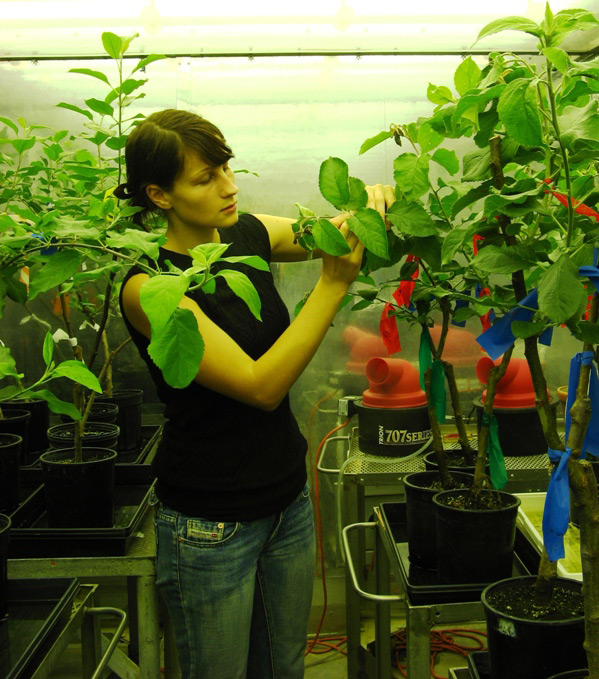diagnostics
The specificity of PCR-based protocols for detection of Erwinia amylovora
| Publication Type | Journal Article | |
| Year of Publication | 2011 | |
| Authors | Powney, R.; Beer, S.V.; Plummer, K.; Luck, J.; Rodoni, B. | |
| Journal Title | Australasian Plant Pathology | |
| Volume | 40 | |
| Issue | 1 | |
| Pages | 87-97 |
Tomato yellow leaf curl virus in Australia: distribution, detection and discovery of naturally occurring defective DNA molecules
| Publication Type | Journal Article | |
| Year of Publication | 2010 | |
| Authors | Van Brunschot, S.L.; Persley, D.M.; Geering, A.D.W.; Campbell, P.R. | |
| Journal Title | Australasian Plant Pathology | |
| Volume | 39 | |
| Issue | 5 | |
| Pages | 412-423 |
Digital Tools for Diagnostics
| Publication Type | Conference Paper | |
| Year of Publication | 2011 | |
| Authors | Kong, G.; Carmichael, A.; Thompson, M.; Farrell, J.; Walker, K.; Beasley, D.; Conroy, J. | |
| Conference Name | Science Exchange 2011 | |
| Conference Start Date | 09/02/2011 | |
| Conference Location | Barossa Valley |
Digital tools for diagnostics
| Publication Type | Presentation | |
| Year of Publication | 2009 | |
| Authors | Kong, G.; Carmichael, A.; Beasley, D.; Farrell, J.; La Salle, J.; Thompson, M. | |
| Meeting Name | CRCNPB 2009 Science Exchange | |
| Meeting Start Date | 22 - 24 September 2009 | |
| Meeting Location | Sunshine Coast |
This project aimed to address the problems associated with the reliability of E. amylovora-specific diagnostics by identifying new diagnostic targets and developing a new diagnostic protocol that can be used as the international standard.
What is the biosecurity problem?
Fire blight, caused by the bacterium Erwinia amylovora, is a destructive disease of apple and pear trees. Fire blight is estimated to cost the United States fruit industry over $100 million a year in crop losses and disease control.
E. amylovora is not currently found in Australia and as such is a major biosecurity threat to the Australian pomefruit industry. Accurate diagnosis of this bacterium is crucial for quarantine testing, incursion detection and incursion management. A number of the internationally accepted PCR tests for identification of E. amylovora used by research laboratories around the world have been found to be unreliable by Australian standards. False negative and false positive PCR results have been observed during routine testing for E. amylovora with some of these tests.
The main outputs of this project were to:
- evaluate available E. amylovora-specific PCR diagnostics
- identify and characterise endemic bacteria found on Fire Blight hosts in Australia
- conduct genomic sequencing of four genetically diverse strains of E. amylovora in order to identify the pan-genome of E. amylovora (the whole genome of the species consisting of core and flexible genomes) to determine the amount of intra-species genetic diversity
- identify new chromosomal diagnostic targets for the detection of E. amylovora using the E. amylovora pan-genome
- detect genetically diverse strains of E. amylovora core sequences of DNA that are conserved between all strains of E. amylovora (but are not present or conserved in closely related bacteria) need to be targeted, and
- validation of new diagnostic targets (PCR and/or micro array analysis)
Who are the end-users of your research?
The end users of this research are the Australian apple and pear industry, state and federal quarantine agencies and associated diagnostic laboratories.

Rachel Powney in the glasshouse at Cornell University
.jpg)
Professor Steven Beer, Jean Bonasera, Rachel Powney and Brendan Rodoni in the Beer Lab at Cornell University
STUDENT

Miss Rachel Powney
Student CRC60037: Fire Blight Diagnostics - PhD
rachel.powney@dpi.vic.gov.au
Phone: 03 9210 9222
Fax: 03 9800 3521
Read More
PROJECT DETAILS
Complete
Supervisor
Dr Brendan Rodoni (DPI VIC) and Dr Kim Plummer (La Trobe University)
Supervising Institution
DPI, Victoria
Term
April 2007 – April 2010
LOCATION
This project established a National Reference Laboratory for Dermestidae, with particular reference to the genus Trogoderma. The laboratory provides molecular and morphological diagnostic services and training. It also provides a resource for other biosecurity projects, potentially providing methods specific to surveillance and contingency plans, in the event of incursion of pest Trogoderma.
Research outcomes:
- A national laboratory with expertise in the diagnostics of khapra beetle and related species has been established within DAFWA
- A trapping program to collect species similar to khapra beetle has been conducted, collecting approximately 10000 specimens from 91 sites around Australia
- There has been ongoing taxonomic work to understand and better recognise khapra beetle and related species and to provide training and other resources to help with the recognition of this pest
- A DNA ‘fingerprint’ type technique has been developed to perhaps allow future identification of khapra beetle using rapid and reliable DNA tests
Research implications:
There has been considerable work done to improve our ability to recognise khapra beetle. Work has been done to study similar species, provide resources to help others identify the species, and develop new tools with the potential to rapidly identify the species. There is a great opportunity for some of these new tools to significantly improve our ability to detect and identify khapra beetle rapidly.
Acknowledgements:
There is a very long list of people warranting thanks, far too many, to be named here. Hopefully all those who’ve assisted with the project and especially AGI collaborators in the trapping programme, understand our appreciation of their efforts. One person requiring special attention is DAFWA’s Mike Grimm who was one of the driving forces behind the project in its early stages.
Thanks to CRC/GRDC for their funding and other support with the project and to DAFWA for their institutional support for the project.
PROJECT DETAILS
Complete
Term
March 2009 - November 2011
Budget
$995,635 (cash and in-kind support)
PROGRAM DETAILS
LOCATION
This project developed advanced molecular diagnostic methods and immunological tools for the detection of plant viruses, which can be expediently applied in both post entry quarantine (PEQ) (import) and market access (export) context. Generic tests that are cost effective and reliable for plant virus detection will help reduce biosecurity risks from importations of plant material to Australia and New Zealand.
Research outcomes
In phase I of this project the project team:
- conducted a review of the importation processes of cereals into Australia and New Zealand
- designed and validated molecular tests that target groups of plant viruses that pose a threat to the grains industry, and
- investigated the application of the Flinders Technology Associates (FTA) card technologies for rapid and safe collection of plant virus samples, as well as storage of viral ribonucleic acid (RNA).
Research implications
This project has identified some areas for improvement for the importation of winter cereals into Australia. A superior diagnostic tool for the detection of potyviruses, the largest plant virus genus, has been developed and validated. A further four plant virus genus-specific tests have been designed and are currently being validated.
Importantly, this project has generated a foundation base for the design, development and validation of quality ready-to-go diagnostic tools to be used by quarantine pathologists. Strategies for the safe transportation of positive controls have also been initiated as a result of this project.
Acknowledgements
The project team would like to acknowledge the following collaborators for their support in project development and continued support for PEQ Phase II (CRC40135):
- Angela Freeman (Victoria Department of Primary Industries)
- John Thomas (Queensland Department of Primary Industries)
- Mark Gibbs (Australian National University)
- Mark Whattam (Australian Quarantine and Inspection Service)
- Kevin Davis (Biosecurity Australia)
- Karen Armstrong (Lincoln University, NZ)
- David Eagling (Cooperative Research Centre for National Plant Biosecurity)
PROJECT LEADER

Dr Brendan Rodoni
Project Leader CRC40050: Post Entry Quarantine (phase one)
brendan.rodoni@dpi.vic.gov.au
Phone: 03 9210 9264
Fax: 03 9800 3521
Read More
PROJECT DETAILS
Complete
Term
January 2008 – June 2009
Budget
$743,721 (cash and in-kind support)
PROGRAM DETAILS
CORE CRC PARTICIPANTS
Flies belonging to the Oriental Fruit Fly species complex, Bactrocera dorsalis, include a number of serious horticultural pest species which are difficult to identify (i.e. B. dorsalis s.s., B. papayae, B. carambolae & B. philippinensis). This project will undertake a comprehensive biological, morphological and molecular study of the complex, to confirm species boundaries and develop new diagnostic methods for their detection.
What is the biosecurity problem?
Tropical fruit flies of the genus Bactrocera are among the most threatening invaders of Australian horticulture, and pest fruit flies of the B. dorsalis species complex dominate Northern Australia Quarantine Strategy, The Australian Quarantine and Inspection Service and industry target lists. Three species within the complex (B. dorsalis s.s., B. papayae and B. philippinensis) are category two pests in the Deed. Unfortunately, despite their importance, these species cannot be adequately resolved from each other, nor from endemic, non-regulated fruit fly species.
The main outputs of this project are to:
- resolve species limits by seeking a consensus result from different tests (morphological, molecular, mating, and host use studies)
- ensure congruency between molecular and morphologically defined taxa within the complex, and
- develop robust molecular diagnostics for the species.
Who will be the end-users of this research?
End-users in Australia will include diagnostic laboratories associated with quarantine and plant health authorities. In addition, once international protocols are established, the test will be available for use by other countries. Benefits will flow on to the Australian and New Zealand horticultural industries.
PROJECT LEADER

Dr Anthony Clarke
Project Leader CRC20115: Resolving the Bactrocera dorsalis Complex
a.clarke@qut.edu.au
Phone: 07 3138 5023
Read More
PROJECT DETAILS
Active
Term
April 2009 – April 2012
Budget
$765,000









